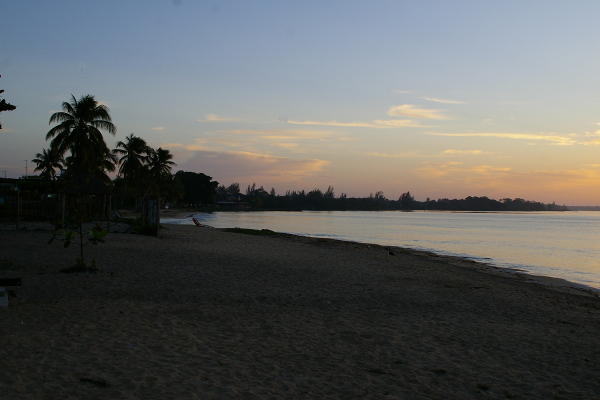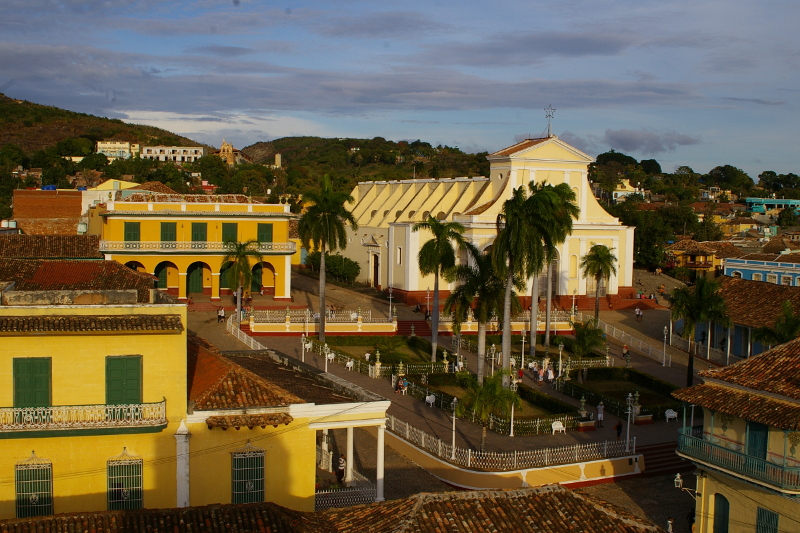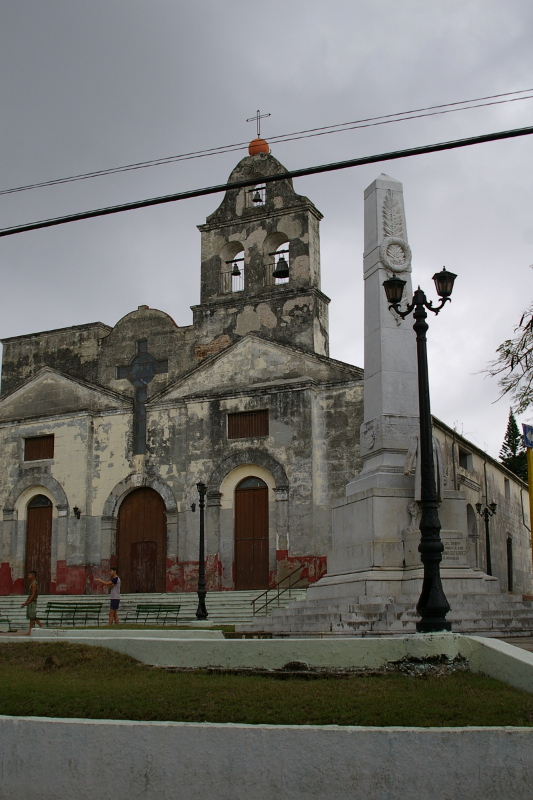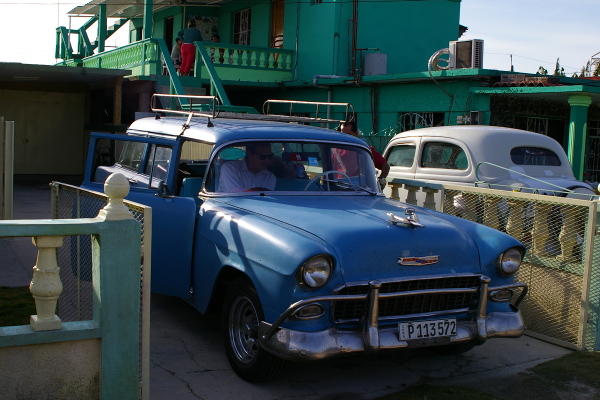 I made a visit to Cuba in January, 2015. I relied heavily on Lonely Planet: Cuba. This publication is a bit too friendly to the current government of Cuba, so I'm taking the trouble here to provide my version of The Real Story.
I made a visit to Cuba in January, 2015. I relied heavily on Lonely Planet: Cuba. This publication is a bit too friendly to the current government of Cuba, so I'm taking the trouble here to provide my version of The Real Story.
First, I did not go to Varadero or any of the all-inclusive resorts. I didn't spend a single night in a regular hotel. This is not what the government wants. They want to transport you from the airport to one of the all-inclusives, and transport you back to the airport a week later. That way, you have near-zero contact with ordinary Cubans, and the government gets nearly all of your money. That's just the way they want it.
If you want to be an independent traveler like I was, the first issue you're going to have to deal with is transportation. Want to ride buses with ordinary Cubans? Forget it. Those buses require an extensive reservation process. And actually, the common means of inter-city transportation for Cubans is a truck equipped with seats, the sort of vehicle used for transporting prisoners (or cows or pigs) in other countries. Cuba has some passenger trains; I considered taking one for the last leg of my trip, and was strongly discouraged from doing so.
What Cuba does have is Viazul, a system of inter-city buses used mostly by tourists. If you can tolerate using Greyhound to get from one place to another, you can probably tolerate Viazul. For longer trips, Viazul gives you very little choice of departure and arrival times. It takes a long time for buses to get you where you're going. Havana to Santiago de Cuba, for example, is advertised as taking 15 ½ hours, but it will almost certainly take a couple of hours longer. That's a distance of 877 km., so this is an average speed of about 50 km./hour. A few of the buses have functioning toilets, but most of them don't. If you should get hungry on the way, they usually make a lunch stop. For any other stop, there's hardly any edible food available, not even a cup of coffee. The biggest nuisance with Viazul, though, is getting a ticket. You're supposed to buy them a couple of days in advance. If you look at the agent the wrong way, he's tell you that he's going to put you on a wait list, and you need to show up at the station an hour before the bus leaves. When you finally get on the bus, you'll discover that it has plenty of empty seats. Or, if you buy a ticket for a trip starting somewhere in the middle of the country, you may discover that all the seats are taken, and you'll have to sit in the aisle for a couple of hours.
So, what are the alternatives? I learned late in the trip that “collectivos” cost the same or not much more than a Viazul ticket, and they have an added advantage; the collectivo driver will usually take you to the doorstep of your overnight accommodation, saving you the cost of a taxi ride. (If you're not familiar with the concept of a collectivo, it's like a taxi, but it doesn't go anywhere until all the seats are full.) Collectivo schedules and departure points are on a word-of-mouth basis, so discuss it with the host of wherever you're staying.
I encountered several bicycle tourists, and they were doing fine. Cuban roads don't have much traffic, and not many hills. Towns and overnight accommodations aren't very far apart, so if you want to travel at a leisurely 50 km./day, you can do it. And, Cuba's rural areas and small towns (especially along the coast) are much prettier than the urban areas. The only drawback is, you're not going to find any spare parts. Do a little net-surfing, and find a list of tools and spare parts (patch kit, extra tube, duct tape) that are necessary for independent touring.
If your intention is to travel the length of the country, you could fly Havana/Santiago de Cuba in one direction. The price for this is a reasonable $160.
I didn't investigate car rentals. I can give you one piece of good news; commercial GPS products like Garmin won't work, but cell phone and tablet GPS apps work fine. The bad news (and Cuba is no different from other foreign countries in this regard) is, if you're involved in an accident, you'll be detained until the investigation is complete. And there will not be a cavalry coming to your rescue.
Where I went
Havana
I stayed in Central Havana, partially because there's a cluster of “casas particular” along Consulado. It's also close to the Malecon, and not far from Old Havana. The Parque Central Hotel is one of the very few places in Havana where you can get WiFi access, at a cost of $8/hour. The area is filthy, though. And Havana's air is dirty, despite very low vehicle traffic. The problem is, Havana has no rail transit, and a lot of the vehicles that are on the road are high polluters.
Old Havana (Habana Viejo) has a lot or restoration work going on, and it's become a tourist trap. (In the Cuban context, “tourist trap” means “everything overpriced”.) There's a lot of live music around, and it seems that every musician in the area has learned how to play “Chan Chan”, the Buena Vista Social Club's best-known song.
The Vedado area is west of Central Havana, and if I were to go to Havana again, I would try to find a place to stay there. It's much more upscale than the rest of Havana. One of Cuba's major architectural landmarks, the Hotel Nacional, is there. If you've seen “The Godfather”, “The Godfather Part II”, or “Havana” (starring Robert Redford), you know something about the Nacional, because there are events that took place at the Nacional that are depicted in these films, even though the actual filming took place elsewhere. If you're a fan of Art Deco, Vedado also has the Hotel Riveira, which was Meyer Lansky's headquarters for a while. The Riviera has a decent-size swimming pool, and if you want to spend a couple of nights in a place that has some history, the Riviera is actually affordable. (Rumour has it that the place still has the original carpeting. And a non-rumour; one of Lansky's heirs is trying to get compensation for the confiscation of this property.)
If Havana is your first stop in Cuba, you won't be able to avoid noticing the scarcity of consumer goods, especially food. The large “mercados” that exist everywhere else in Latin America don't exist in Cuba. However, if you're looking for a bottle of Havana Club rum, you won't have to walk more than a half block in any direction. There are entire stores that have nothing on the shelves except this product. The question becomes, just how many bottles of rum can you drink over the course of a week or two?
For me, Havana had two big attractions. The first is the Hemingway Museum. It's in San Francisco de Paula, which is 15 km. from the centre of Havana. The Cuban government has done a creditable job of keeping it similar to the way Hemingway left it in 1960. The museum also includes Hemingway's boat, the Pilar. Visitors aren't allowed to go inside the house; you just look in through the windows, instead. I didn't see this as a problem.
The other is Estadio America Latina, home of the Industriales, the baseball team that all Cubans who live somewhere other than Havana hate. The caliber of play in the Cuban National Series is very good, and they charge a special Gringo price of $3 for a seat behind home plate. Unfortunately, the mens' toilet in the place is filthy. (More on this topic later.)
Havana's Malecón should be a major attraction, but, like a lot of other things in Havana, it's been allowed to deteriorate badly.
I stayed at the Sra. Nurmis Borges casa particular at Virtudes 65 the first night, and that's where I had the best cup of coffee of the trip. (I tried, without success, to get this place listed in Trip Advisor.) I had several good meals at the nearby Hostal Peregrino, Consulado 162.
 Bay of Pigs (Bahia de Cochinos)
Bay of Pigs (Bahia de Cochinos)
The Bay of Pigs is a good place to go to get away from it all. Very quiet (few cars, no motorboats), and inexpensive. There are no hotels, but about half of the houses in Playa Larga, where I stayed, are casas particular. The main attraction of the area, unless you're a mid-20th-century history buff, is the Cienega de Zapata, the largest swamp in the Caribbean, which surrounds the bay. There's also the Cueva de los Peces, a good spot to go snorkeling or scuba diving.
I stayed at the Hostal Enrique, and it was the best accommodation I had on the trip. The price there includes both dinner and breakfast, and they don't have a shortage of food. The thing that impressed me about Playa Larga is, the businesses there operate their own local economy. Enrique will book you for various tours, and he also set me up with a collectivo to get me to Trinidad. Business opportunity: Playa Larga could use a good coffee bar. The local Etecsa office (the government-run internet access) closes at 4 PM, isn't open on Sunday, and has only one computer. So, open up a cyber cafe with good coffee, and you've got a winner.
Now, about that mid-20th-century history: there was some action at Playa Larga during the Bay of Pigs invasion, but most of it was at Playa Girón, at the eastern side of the mouth of the Bay of Pigs. Playa Girón has a museum, and the Cuban government treats the invasion like it was Trenton, Gettysburg, or Normandy. There are monuments and billboards all around the bay, including an individual monument to every one of the 176 Cuban soldiers killed in the invasion.
 Trinidad
Trinidad
Trinidad was a place I had really looked forward to going to, and it was a disappointment. It was founded in 1514, so it's one of the oldest European settlements in the Americas. (Baracoa, founded in 1511, is older. So is Bayamo, founded in 1513.) It's a UNESCO World Heritage site. But after you take pictures of the principal buildings and put them up on Facebook, what do you do next? The place is badly overrun with tourists, but, like a lot of other places in Cuba, it's difficult to find a decent meal.
Two things about Trinidad I did like were the Casa de la Música (House of Music), which is actually outdoors, and the nearby beach, Playa Ancón.
Bayamo
I arrived in Bayamo after 8 PM. (Viazul was supposed to get me there a couple of hours earlier.) I was hungry, and there were no snack bars or grocery stores of any sort still open. And one restaurant, at the Hotel Royalton on Parque Céspedes, which turned out to be pretty good.
Bayamo is a bit more upscale than everywhere else I went to. The main street is a pedestrian mall, and there are a few stores on it that actually have some goods to sell. The primary forms of transportation there are bicycles and bicycle taxis. This makes sense; the city is flat, and a bicycle can get you from one end of town to the other in 15 minutes.
Bayamo is off the path beaten by tourists. There's some history there of primary interest to Cubans. The 19th century revolutionary Carlos Manuel de Céspedes lived there. I went there to see Granma, Bayamo's baseball team, which is traditionally one of Cuba's best teams.
 Santa Clara
Santa Clara
Several people along the way told me that Santa Clara was better than Trinidad, Bayamo, or wherever I was at the time. Well, there are some interesting buildings and old churches, but it still wasn't that great. I did not go to the Che Guevara monument; I've heard enough about him already. However, I did go to the Monument to the Taking of the Armoured Train, and that was pretty interesting. The story is, on December 29, 1958, Guevara and 18 men derailed an armoured train carrying government troops, attacked it with Molotov cocktails, and took the 350 men on board as prisoners. It was just a skirmish, but it proved that the government army was ineffective, and Batista fled the country less than two days later. The site of this skirmish is a park/museum, with cars from the train, and the bulldozer that was used to cause the derailment.
Where I didn't go
I heard and read a lot of good things about Cienfuegos, but just couldn't fit it in. I also would have liked to go to Santiago de Cuba and Baracoa, but, as I pointed out at the beginning, it takes a long time to get from one part of Cuba to another.
There's a lot of sparsely inhabited, or even uninhabited, islands on the north side of Cuba. Deep sea fishing expeditions are available on some of them, at reasonable prices. The Cuban government is also working on putting up resorts on several of them.
Some general useful information
Food: I've already mentioned that it's scarce and generally low quality. Two important pieces of advice: never order pasta in a restaurant; Chef Boyardee is good by comparison. And if you don't like coffee with sugar in it, learn to say, “sin azucar”; otherwise, you'll end up with something yucky.
Most Cuban restaurants and snack bars don't provide napkins.
Getting there: With the demise of Interjet, the only airline with Mexico City-Havana nonstops is Aeromexico.
You have to pay for a tourist visa before you get on a plane to Cuba; you can buy it at the airport you're departing from, and it costs about $20. You also have to pay an exit tax when you leave Cuba, and this is another $25. Payable in cash only, and don't ask me what happens if you've run out of money.
Cuba also requires that you have travel insurance. Since I moved to Mexico, I've been getting this from aseguratuviaje.com. I can't vouch for the quality of their coverage, because I haven't had to make a claim yet.
Customs clearance at the Havana airport takes a long time. And, you'll need CUC's to pay for your taxi ride into town. So, you'll have to stand in line again to buy CUC's.
Toilets: Most public “baños” in Mexico have a man or woman at the entrance charging three or four pesos for admission. I'm perfectly OK with this, because the person collecting the money keeps the toilet clean. Well, toilets in Cuba have a person collecting money, too, but they are unaware of any corresponding obligation to clean the toilets.
 Ancient taxis: Yes, I rode in one taxi that was older than I am. Another, a 1955 Plymouth, that was very similar to the car my grandmother had. There was a 1955 Chevy that actually had a Toyota diesel engine. Makes sense; diesel fuel in Cuba costs about half as much as gasoline. These vehicles look cool, but the upholstery in them was shot a long time ago. I rode in a couple of 1980's vintage Ladas, and they were a lot more comfortable. Ladas are another example of cars that just run forever.
Ancient taxis: Yes, I rode in one taxi that was older than I am. Another, a 1955 Plymouth, that was very similar to the car my grandmother had. There was a 1955 Chevy that actually had a Toyota diesel engine. Makes sense; diesel fuel in Cuba costs about half as much as gasoline. These vehicles look cool, but the upholstery in them was shot a long time ago. I rode in a couple of 1980's vintage Ladas, and they were a lot more comfortable. Ladas are another example of cars that just run forever.
Propaganda: Cuba has plenty of billboards. Instead of advertising Coca-Cola, KFC, or whatever, they promote “virtue by association.” Most people know that the Castro brothers are past their shelf life, so what they do is show pictures of José Martí (everybody likes him), Hugo Chávez, and occasionally Evo Morales or Rafael Correa, with Raúl.
Skype does not work anywhere in Cuba, and long distance phone calls to North America are very expensive.
Money: Credit and debit cards from US banks will not work in Cuba. Nor will the Canadian Capital One MasterCard, which presumably means that Canadian MBNA MasterCards won't work, either. Nor do Canadian debit cards. Visa cards will work in Cuban ATM machines, and MasterCards will not. You can still get money with a MasterCard by going into a bank and dealing with a teller; don't forget to bring your passport. Banks aren't open on Saturdays. If you intend to use a credit card to withdraw money, it's a good idea to let your bank know that you're going to Cuba. Otherwise, you might get your withdrawals blocked because they are identified as suspicious transactions.
You'll learn very quickly that Cuba has two official currencies, pesos and CUC's (convertible currency). Most cash transactions for tourists will be in CUC's, which are always worth one US dollar. Sometimes you'll see restaurant menus with prices in pesos, and they are 24 or 25 to the dollar. The government apparently plans to phase out CUC's; I saw news stories about printing pesos in larger denominations.
Cuba has very little violent crime, because committing criminal acts results in stiff prison sentences. However, Cuba is a very poor country; Guatemala is prosperous by comparison. The introduction of CUC's has created two classes of Cubans; those with access to CUC's, and everyone else. The “everyone else” makes the equivalent of $20 per month, and just about anything worth buying is priced in CUC's.
So, there are people, known as “jinoteros”, who are always looking for petty ways of separating tourists from their money. What happens a lot is, you'll be quoted a price for something (taxi rides are a good example, because taxis don't have meters), and when the time comes to pay up, the price magically increases by five or ten dollars. If you question it, they'll come up with some story about there being a “tax”.
One racket that I found distasteful is, when you arrive in a city, the taxi driver who takes you to your accommodation will try to collect a commission from the proprietor of the casa particular for bringing him a customer. In a couple of cases, the proprietor asked who directed me to his establishment, and the answer was Lonely Planet. (Had I answered falsely, the commission that he paid the taxi driver would have been passed along to me.) This resulted in arguments between the proprietor and the taxi driver; not a real problem, but the sort of thing you would rather not listen to when you're on vacation.
Gifts: I knew before I went that Cuba has shortages of every imaginable type of consumer goods. I read somewhere that bars of soap and socks were good things to give away, so that's what I brought with me. Clothing is very scarce, so the socks are still a good idea. However, it is possible to buy bars of soap in stores, although the ones I saw had to be paid for with CUC's. I noticed that there is a severe shortage of paper in Cuba, so bringing along a stack of spiral notebooks would be a good idea.
Television: There is no cable in Cuba. One thing you'll quickly notice on arrival is television antennas everywhere. What's available on television is generally pretty good. I watched the 7 PM official Cuban news one night, and it looked and sounded a lot like Fox News, without the mandatory blond bimbo. There's an an all-sports channel, and if you're into baseball, it sometimes shows three games a day.
A conclusion about politics and economics: I occasionally encounter apologists for the Castro regime, and I say that, if you're one of those people, the Castros are unworthy of your sympathy. Yes, things were bad during the Batista regime, but it's been 55 years since he was deposed, and he's been dead since 1971. I'll address two specific fallacies:
1. The Great American Satan is keeping Cuba down: Actually, Cuba does plenty of trade with Venezuela, China, Korea, and Holland. Cuba gets plenty of foreign investment from the multinational resort hotel operators, such as Spain-based Iberostar. The thing about trade is, if you want to receive something, you have to provide something in return. Cuba's exports are sugar (and rum, a sugar product), tobacco, and coffee. These are all products that are available in large quantities from lots of other countries.
2. The Cuban government is, at least, feeding its people: No, they aren't. Cuba imports over 80% of its food, despite the fact that the country has an ideal climate for growing stuff, and has a large amount of unused agricultural land. The problem is, planting and harvesting crops is hard work, and it's generally regarded as “someone else's job.” Here's a clue for the people who call the shots for Cuba: if you want to reduce your food imports (so that you can use your foreign exchange to bring in important stuff like building supplies and buses), for goodness sakes, pay people to produce food. After all, didn't Marx say, “workers, unite, you have nothing to lose but your chains”? Show your workers that the work that they do has value.
More pictures here



